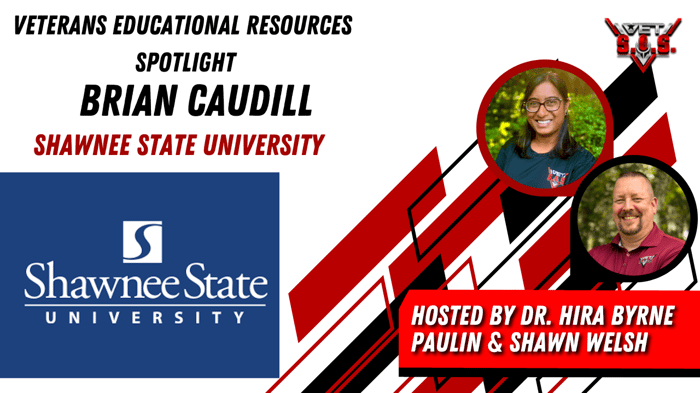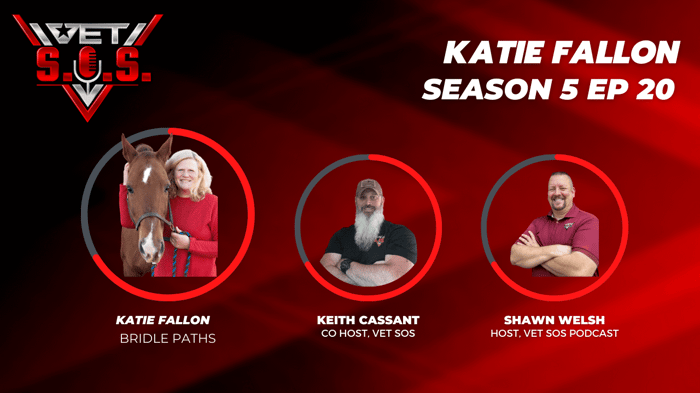How Shawnee State University Exemplifies Veteran Support Services in Higher Education
Transitioning from active military service to college life is a major adjustment. For many veterans, the shift involves far more than just academics—it includes adjusting to a new culture, managing personal responsibilities, navigating complex benefit systems, and finding a community that understands their background. In recent years, more universities have begun to invest in comprehensive veteran support services in higher education, and Shawnee State University has become a standout example of what’s possible when veterans are placed at the center of student success strategies.
In a recent episode of the VET S.O.S. Veteran Educational Resources Spotlight, Brian Caudill, a U.S. Air Force veteran and Veteran Engagement Coordinator at Shawnee State University, shared his story and how his personal experience has informed the development of veteran-specific programs that are making a real difference on campus.
Understanding the Veteran Experience
Before diving into Shawnee State’s model, it's important to understand what makes the veteran student population unique. Veterans are often non-traditional students, entering higher education later in life, sometimes with families, and usually with real-world work and leadership experience. They face a range of challenges, including:
Understanding how to maximize GI Bill benefits
Balancing family and academic responsibilities
Finding a sense of belonging in a younger, traditional campus environment
Managing service-related physical and mental health issues
 Brian Caudill
Brian CaudillBrian Caudill understands these struggles because he lived them. After leaving the U.S. Air Force, he used his Post-9/11 GI Bill benefits to attend the University of Arizona. At the same time, his wife—also an Air Force veteran—remained on active duty. Juggling parenthood, schoolwork, and transition challenges, Brian became deeply aware of how essential strong veteran support services in higher education are to a successful academic journey.
A Veteran-Ready Campus at Shawnee State
 Today, Brian uses that experience to serve over 110 military-affiliated students at Shawnee State University in southern Ohio. His approach focuses on building a veteran-ready environment—not just in name, but in practice.
Today, Brian uses that experience to serve over 110 military-affiliated students at Shawnee State University in southern Ohio. His approach focuses on building a veteran-ready environment—not just in name, but in practice.
1. Veterans’ Center with Real-World Comforts
One of Shawnee State’s most visible signs of support is its dedicated veterans' lounge, a physical space designed specifically for comfort, community, and convenience. Amenities include:
Massage chairs for stress relief
Video games to foster camaraderie
A snack bar for quick, accessible nutrition
A quiet study room for focused work
Free printing and laptops available for checkout
A textbook library, reducing the financial burden of course materials
These features go beyond simple accommodations—they represent a commitment to reducing stress, promoting academic focus, and ensuring that veterans feel respected and cared for.
“These spaces are more than perks. They help build community, reduce isolation, and create a sense of normalcy that’s critical during transition,” Brian explains.
2. One-on-One Advocacy and Guidance
Veteran support services in higher education must go beyond physical spaces—they need to include personalized, knowledgeable guidance. At Shawnee State, Brian takes a hands-on approach to working with students individually.
Whether it's navigating benefits, resolving class conflicts, or just listening, Brian emphasizes personal connection and proactive advocacy. He knows that each student has a different background, and a one-size-fits-all model doesn't work for military-connected learners.
3. The Shawnee Service Corps: Community and Purpose
Another pillar of Shawnee State’s veteran support strategy is the Shawnee Service Corps, a student-led initiative that encourages community involvement. Veterans who join the Corps participate in local service projects and outreach efforts, creating a sense of mission and purpose that mirrors the values of their military service.
By promoting peer engagement and service, Shawnee State helps veterans not only stay active in the community but also develop relationships and skills that enhance their college experience.
4. Veterans Recognition Day and Campus Culture
Shawnee State’s annual Veterans Recognition Day is more than just a celebration—it’s a university-wide moment to acknowledge the service and sacrifice of military students and alumni. The event includes:
Guest speakers
Resource fairs
Recognition ceremonies
Community networking opportunities
These events help increase visibility and appreciation for the veteran population on campus, reinforcing a culture that values military service.
Lessons from a Veteran Engagement Leader
Brian Caudill believes that successful veteran support services in higher education begin with empathy and lived experience. His own journey informs his message to students:
“Ask for help. Use the resources available to you. You don’t have to navigate this alone.”
He encourages veterans to engage early, whether through the lounge, student organizations, or outreach programs. The earlier students connect, the more confident and capable they become over time.
The Broader Importance of Veteran Support Services in Higher Education
As thousands of veterans and military-connected students continue to use GI Bill benefits to pursue college degrees, universities must evolve to meet their needs. Institutions like Shawnee State University serve as models for veteran-ready campuses, showing how intentional design, dedicated staff, and a culture of support can make a real difference.
Veteran support services in higher education should aim to:
Provide accessible spaces and resources tailored to veteran lifestyles
Offer mental health and wellness tools
Ensure academic success through tutoring, technology access, and textbook support
Promote community and belonging through events and peer programs
Employ veterans or trained staff who understand the nuances of military culture
A Blueprint for Institutions Nationwide
For other schools aiming to enhance their own veteran support systems, Shawnee State offers a compelling blueprint:
Start with listening—gather input directly from your student veterans.
Design a space that’s welcoming and functional, not just symbolic.
Offer practical resources like free printing, laptops, and textbook libraries.
Create opportunities for veterans to serve, such as through volunteer programs.
Celebrate veterans year-round, not just in November.
Appoint leaders with military experience, like Brian, who can build trust.
Final Thoughts: No One Transitions Alone
The journey from the military to the classroom is filled with both opportunity and challenge. When universities take the time to implement comprehensive veteran support services in higher education, they don’t just help individual students—they enrich the entire campus community.
Thanks to leaders like Brian Caudill and institutions like Shawnee State University, veterans across the country can find the support they need to succeed—academically, professionally, and personally.
At VET S.O.S., we believe in the power of connection, storytelling, and shared resources. Brian’s work reminds us that no one transitions alone—especially when the right people, programs, and purpose are in place.





